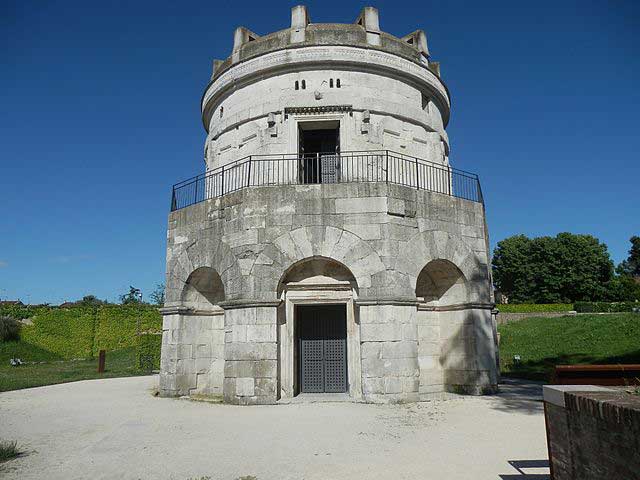BISHOP JOHN MADE PEACE AND RAISED THE SEIGE OF RAVENNA

[Mausoleum of Theoderic —Spartakos / [GNU Free Documentation License, Version 1.2 CC-BY-SA 3.0] Wikimedia File:Mausoleum of Theoderic.JPG]
THE GOTHS were a plague to the late Roman Empire, but useful to it, too. Toward the end of the fifth century, Theodoric, leader of the Ostrogoths, proposed that Zeno, the Emperor at Byzantium, commission him to march against Odovacar who held Italy. If successful, Theodoric would rule Italy for Zeno and the Roman Senate. Zeno agreed. (Some historians credit Zeno with the suggestion.)
Theodoric, who had spent his boyhood as a hostage in Constantinople and admired Roman civilization, soon was on the march with his soldiers and their families. These Goths had converted to the Arian form of Christianity a century earlier. Their fierce behavior was hardly modified by the gospel, but they respected Christian sites and Christian leaders.
Arriving in Italy in 489, Theodoric defeated Odovacar in several engagements. By 493, he had control of most of the peninsula, although Odovacar had not been dislodged from Ravenna. For two and a half years, Theodoric besieged the city. Odovacer managed to hit Theodoric with a few strong counter attacks, but eventually Theodoric’s blockade by land and sea made food so scarce in Ravenna that a quarter of a bushel of wheat cost over $600 (in 2020 US dollars).*
Finally Odovacar had to seek terms. He asked bishop John to handle the negotiations. Theodoric received John favorably and talks continued for three days late in February, resulting in an agreement by 27 February.
On this day, 5 March 493, the city completed its surrender. Bishop John emerged through the open gates with a retinue of monks, crosses, and copies of the Gospels; intoning psalms, he fell at the conqueror’s feet requesting peace and mercy.
For ten days Odovacar and Theodoric lived side by side, praising one another and pretending friendship until, at a dinner, Theodoric had two suppliants go to their knees before Odovacar and clutch his hands as if to plead with him, whereupon Theodoric struck him dead with a single blow while his hands were immobilized.
Theodoric’s deplorable breach of hospitality may have had some justification because it seems Odovacar was plotting against the conqueror, trying to stir up disaffection among his followers. Despite the treachery, Theodoric proved a strong and largely peaceable ruler. He brought stability and quiet to Italy for a third of a century. He was largely a just king and maintained the fiction that he was acting as a vassal to the emperor in the east. Although always an Arian, he allowed the practice of Roman-style Christianity and observed Roman laws. However, his reign was further blemished with the judicial murder of the great philosopher Boethius on false charges.
When Theodoric died in 526, he was buried in an impressive mausoleum. Bishop John, for his part, died the year after he negotiated Ravenna’s surrender. Eventually named a saint, his feast is observed on 12 January.
—Dan Graves
* Thomas Hodgkins’s Theodoric the Goth (1894) says a peck (1/4 bushel) of “corn” (i.e., wheat) cost 72 shillings, or £3.6. An 1894 pound was equivalent to £130.83 in 2020. £3.6 pounds in 1894 would therefore be worth £471 in 2020. At the exchange rate with the US dollar in late 2020, that would be $631.
----- ----- -----
For more background on this period in the church, watch History of Christianity at RedeemTV.
History of Christianity can also be purchased at Vision Video.







